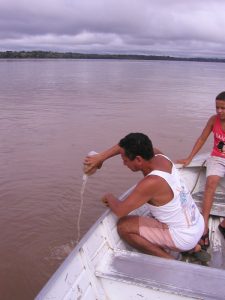Choice of sampling locationDuring the field campaigns performed to setup the stations, the sampling feasibility was tested at each gauge station, especially:
|

|
Equipment made available to the observerEach operator received the equipment needed to sample during a whole year and a document with instructions for sampling and filtration, in Spanish or Portuguese language. The equipment consists of:
|
|
SamplingThe sampling equipment must have been prepared at GET-Toulouse according to the following procedure:
The set filtration filters are first weighted and the weight is reported on a label sticked on the protection bag which is then hermetically closed. All the bottles are labeled with the station name and their future use and placed in plastic bags closed by a zipper. The filtered sample, as the filters, are kept by the operators in insulating compartments in order to prevent them from temperature variation, dust and light. They are regularly sent to Brasília, either through field campaigns opportunity or by mail. Special filtrations for the POC are operated since april 2006 in 6 Brazil located stations: Óbidos , Itaituba, Borba, Manacapuru, Caracarai and Serrinha. To do that, special equipment (filtration sets with GFF filters first pyrolyzed at 480° C) is provided to the operators in order to perform a specific filtration of 300 ml for the DOC. |
|

